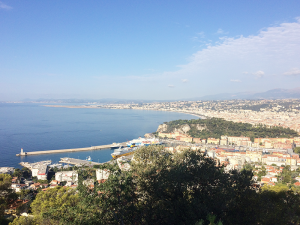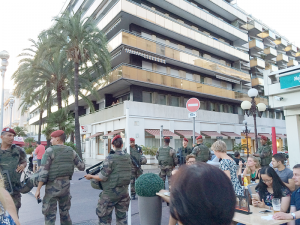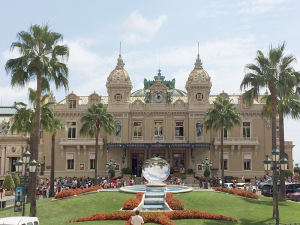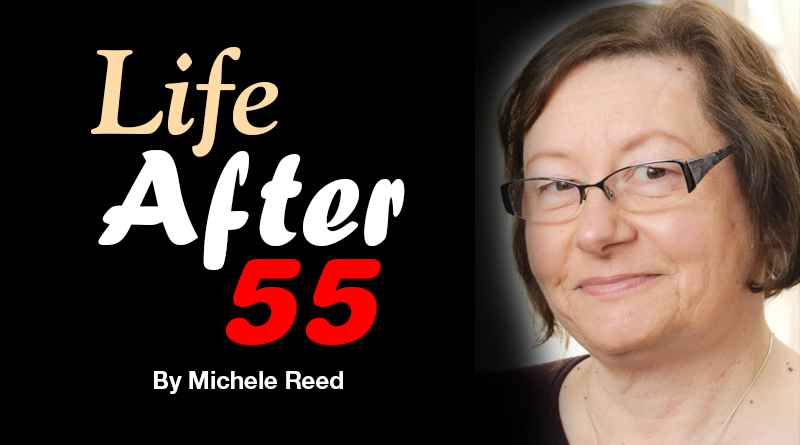The Good Life Goes On in Nice
By Michele Reed
michele@cny55.com

We had arrived at the Nice Centre Ville train station only about 40 minutes earlier, deposited our bags at our hotel, and headed for the famous Promenade des Anglais. It was early evening and we didn’t want to waste a minute of our brief sojourn at the glamorous Cote d’Azur resort. We had spent the winter planning with our cousin, who would be visiting us in August, to spend her last three days in Europe in Nice, where she would hop a plane to her son’s wedding in China.
We walked through crowds of holiday tourists in the latest designer sunwear, carrying beach bags and sipping cold drinks. All around us we could hear conversations in German, Dutch, Italian, Spanish, English and of course, French.
Passing through the 19th Century Neoclassical Place Massena, dominated by a monumental statue of Apollo, we had the shore in our sight, when we saw it. A huge line of flowers, candles and stuffed animals. We had arrived at victims ground zero of the Bastille Day terror attack on July 14. Several such memorials dotted the two-mile-long path of the truck, which killed 85 men, women and children celebrating France’s biggest national holiday.
Like many people out to enjoy the last rays of the sun that day, we stopped to pay our respects and read the memorial messages. We knew how hard the tragedy hit our neighbors in the south of France. Attacks in Paris and Brussels were tragic, but they seemed far away. This one hit close to home. “Je suis Nice” signs popped up around southern cities. Some locales canceled summer festivals.
But another, stronger force was at work here: the indomitable spirit of the French people. What we found was that, in true French fashion, life goes on. The French national news said that numbers of holiday-goers in Nice were down this year, and they probably were, but the place was still hopping. Families still frolicked on the beach. Seaside bars and clubs blared music and lit the night with strobes. Restaurants were packed with people enjoying great food and wine.
Not that security wasn’t tight. Soldiers with bulletproof vests and automatic weapons patrolled in groups. We saw a half dozen outside the Hard Rock Café. Security guards searched purses and bags when we entered a mall or large department store.

Taking our cue from the French however, we vowed to make the most of our time in the seaside city. We enjoyed beer and charcuterie at a typical brasserie and a meal of salad Nicoise full of tuna and anchovies, fish soup and grilled sea bass accompanied by a delicious local white wine.
We took a guided tour, where we saw the changing of the guard at the palace in Monaco, and the casino and Formula 1 course in Monte Carlo. A breathtaking ride on the Middle Corniche, with our minivan hugging curves with a sheer drop off the huge cliff above the Mediterranean provided spectacular views, not only of Nice but of Saint-Jean-Cap-Ferrat, where the rich and famous have their summer homes (Angelina Jolie and Brad Pitt, George Clooney and the Rothchilds all have homes there).
A visit to the medieval perfume-making town of Eze provided a steep climb to the light ochre Church of Our Lady of the Assumption. Since the bus was only stopping for a short time, we didn’t try to make our way to the very top to check out the ruined chateau, but upon climbing down we were amazed at how very far we had climbed, as we stared at the church tower 1,400 feet above sea level.
A tour of Nice on the “Little White Train” (a phenomenon popular in all Southern French cities) gave us a sense of the history of the place.
Founded by the Greeks in 350 BC and named after Nike, the goddess of victory, it was one of the few safe harbors along the rocky coast. As such, it was terribly important and so changed hands many times. Over the course of its long history, it was ruled by Greeks, Italians and the Dukes of Savoy. It only became French again in 1860.
We hoped for a spectacular ending to our last day in Nice, and we weren’t disappointed. After listening to an impromptu concert by a Chilean cumbia band, and buying their CD, we headed once again for the Promenade des Anglais.

The Mediterranean was the bluest turquoise we’d ever seen, although the beach, which the guidebooks describe as “pebbly,” is actually composed of fist-sized rocks — think Selkirk Shores along Lake Ontario. After negotiating the rocky beach and dipping our toes in the sea, later that evening we shared a magnificent seafood dinner at a restaurant located right on the shore, while waves crashed just feet from our table and the full moon was reflected in the waters of the sea. We watched the lights of cruise ships recede into the night and marveled at the magnificent pink dome of the 1912 Hotel Negresco dominating the skyline.
As we walked back to our hotel with the sounds of music from a rooftop party tickling our ears, we reflected that it is true. Although French routine may be shaken, no matter what happens, la bonne vie — the good life — goes on.
Michele Reed retired after a career spanning four decades in public relations, advertising, journalism and higher education. She now writes travel articles, book reviews, haiku poetry and fiction. Bill Reed retired after four decades in social services with the county of Oswego, and now works at travel photography and photojournalism, along with writing book reviews.

